A Change in Leaf Color
Leaves go to a lot of trouble to turn red in the fall.
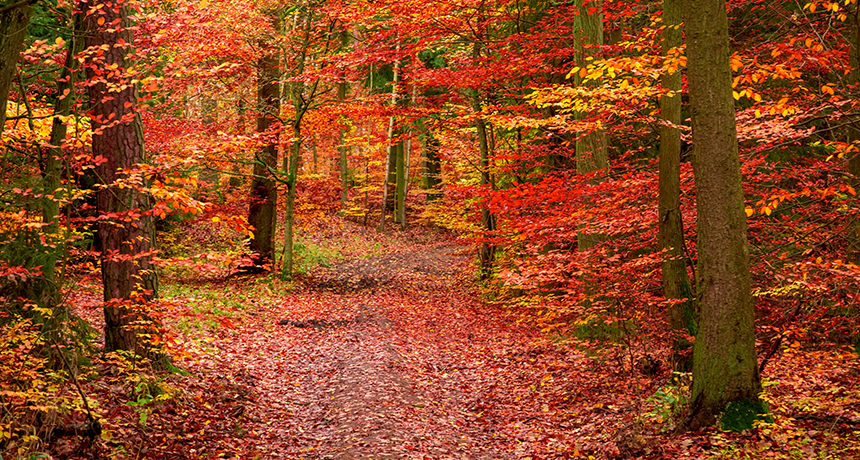
Fall foliage transforms trees of green into stunning shades of yellow and red.
Shaiith/iStockphoto
By Emily Sohn
Every autumn, traffic creeps along New England’s roads as visitors look everywhere but at the road. These tourists flock to the region as soon as leaves begin to change color from a summery green to spectacular shades of red, orange, yellow, and purple.
“Being in the Northeast during autumn is just about as good as it gets in this country,” says David Lee. He’s a botanist at Florida International University in Miami.
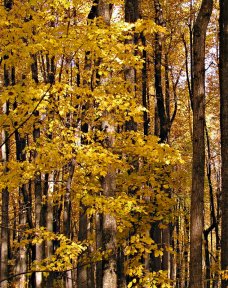
Lee studies leaf color, so he’s biased. But plenty of other people share his admiration. Areas of the United States with especially colorful fall displays attract thousands of leaf peepers.
Even as they “ooh” and “aah,” few people know what makes many plants blush in the autumn. Research has shown that leaves change color when their food-making processes shut off. The chemical chlorophyll, which gives leaves their green color, breaks down. This allows other leaf pigments—yellow and orange—to become visible.
But “there’s still a lot we don’t know about this,” Lee says.
It isn’t clear, for example, why different species of plants turn different colors. Or why some trees become redder than others, even when they’re standing right next to each other. And no one knows exactly how global warming will alter forests and affect leaf-peeping season.
Food factory
In summer, when a plant is green, its leaves contain the pigment chlorophyll, which absorbs all colors of sunlight except green. We see the reflected green light.
The plant uses the energy it absorbs from the sun to turn carbon dioxide and water into sugars (food) and oxygen (waste). The process is called photosynthesis.
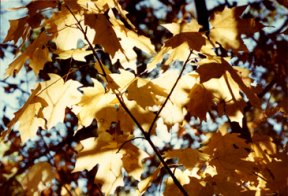
As days get shorter and colder in the autumn, chlorophyll molecules break down. Leaves quickly lose their green color. Some leaves begin to look yellow or orange because they still contain pigments called carotenoids. One such pigment, carotene, gives carrots their bright-orange color.
But red is special. This brilliant color appears only because the leaves of some plants, including maples, actually produce new pigments, called anthocyanins.
That’s a strange thing for a plant to do without a reason, says Bill Hoch of the University of Wisconsin in Madison. Why? Because it takes a lot of energy to make anthocyanins.
Why red?
To figure out the purpose of the red pigment, Hoch and his coworkers bred mutant plants that can’t make anthocyanins and compared them with plants that do make anthocyanins. They found that plants that can make red pigments continue to absorb nutrients from their leaves long after the mutant plants have stopped.
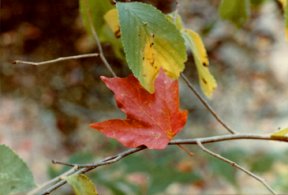
This study and others suggest that anthocyanins work like a sunscreen. When chlorophyll breaks down, a plant’s leaves become vulnerable to the sun’s harsh rays. By turning red, plants protect themselves from sun damage. They can continue to take nutrients out of their dying leaves. These reserves help the plants stay healthy through the winter.
The more anthocyanins a plant produces, the redder its leaves become. This explains why colors vary from year to year, and even from tree to tree. Stressful conditions, such as drought and disease, often make a season redder.
Now, Hoch is breeding plants for a new set of experiments. He wants to find out whether turning red helps plants survive cold weather.
“There’s a clear correlation between environments that get colder in the fall and the amount of red produced,” he says. “Red maples turn bright red in Wisconsin. In Florida, they don’t turn nearly as bright.”
More protection
Elsewhere, scientists are looking at anthocyanins in other ways. A recent study in Greece, for instance, found that as leaves grow redder, insects eat them less. On the basis of this observation, some scientists argue that red pigments defend a plant against bugs.
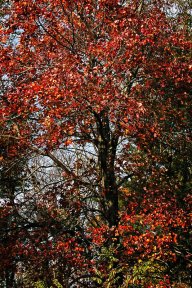
Hoch rejects that theory, but Lee thinks that it might make sense. He points out that red leaves contain less nitrogen than green ones do. “It may actually be that insects avoid red leaves because they’re less nutritious,” Lee says.
However, “it’s pretty confusing at this point,” Lee admits. “People debate back and forth.”
To settle the debate, scientists will need to look at more species under more conditions, Lee says. So, he’s now researching leafy plants rather than trees. He’s especially interested in tropical plants, whose leaves turn red when they’re young rather than old.
You can do your own leafy experiments. Observe the trees in your neighborhood and keep track of weather conditions. When autumn begins, write down when the leaves change, which species change first, and how rich the colors are. You can even see anthocyanins under a simple microscope. After several years, you might start to notice some patterns.
Going Deeper:







